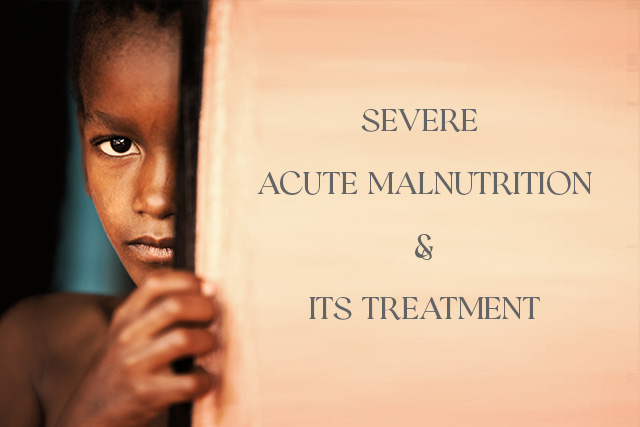Severe acute malnutrition (SAM) is a serious condition that affects millions of children worldwide, primarily in low- and middle-income countries. SAM is characterized by very low weight for a child’s age and height, as well as other signs of malnutrition such as muscle wasting and edema. Children with SAM are at high risk of morbidity and mortality, as they are more susceptible to infections and other illnesses.
The main cause of SAM is a lack of adequate nutrition, which can be due to poverty, lack of access to clean water and sanitation, and inadequate healthcare. The main treatment for SAM is the provision of specialized nutritious foods, such as ready-to-use therapeutic foods (RUTF), which are high in energy and protein. Children with SAM may also receive other forms of care, such as antibiotics to treat infections and micronutrient supplements to address deficiencies.
Regular monitoring and follow-up are important for children with SAM to ensure that they are gaining weight and recovering from the condition. Community-based interventions to improve child feeding practices, hygiene, and disease prevention can also help to prevent malnutrition. Malnutrition is responsible for nearly half of the deaths in children under 5 years old, and SAM is responsible for a significant proportion of these deaths.
Severe acute malnutrition (SAM) in children can have a number of serious effects on a child’s health, including
Increased risk of morbidity and mortality: Children with SAM are at a higher risk of dying from infections and other illnesses due to their weakened immune systems.
Stunted growth: Malnutrition can cause stunted growth, which means that a child’s height and weight will be significantly below average for their age.
Cognitive and developmental delays: Malnutrition can affect a child’s brain development, leading to cognitive and developmental delays.
Weakness and fatigue: SAM can lead to muscle wasting and weakness, making it difficult for a child to engage in physical activity and play.
Anemia: SAM can cause anemia, which is a condition characterized by a lack of red blood cells. This can lead to fatigue, weakness, and a greater risk of infections.
Increased risk of infections: Malnutrition can make a child more susceptible to infections such as diarrhea, pneumonia, and measles.
Poor wound healing: Children with SAM may have difficulty healing from injuries or wounds due to the lack of protein and other nutrients needed for repair.
Increased risk of death: Children with SAM are at a higher risk of dying from malnutrition and associated infections.
Long-term effects: Malnutrition during early childhood can have a long-lasting impact on physical and cognitive development, even after adequate nutrition is resumed.
Preventing and treating malnutrition is crucial for children’s survival, growth, and development, it’s also an effective way to break the cycle of poverty and improve overall health outcomes.
The main treatment for severe acute malnutrition (SAM) in children is the provision of specialized nutritious foods, such as ready-to-use therapeutic foods (RUTF). RUTF is high in energy and protein and can be given to children without the need for cooking or preparation. They are typically provided in a clinic or hospital setting and are usually given to children until they have gained enough weight and their nutritional status has improved.
Antibiotics to treat infections: Children with SAM are more susceptible to infections, so they may be given antibiotics to prevent and treat illnesses.
Micronutrient supplements: Children with SAM may be deficient in certain vitamins and minerals, so they may be given supplements to address these deficiencies.
Rehydration therapy: Children with SAM may be dehydrated due to diarrhea or other illnesses, so they may be given fluids to rehydrate them.
Education on Child Feeding: Parents, caregivers, or family members may receive education on appropriate feeding practices to prevent further malnourishment.
Follow-up and monitoring: Children with SAM should be regularly monitored to ensure that they are gaining weight and recovering from the condition.
Community-based interventions: To prevent malnutrition, community-based interventions such as improving child feeding practices, hygiene, and disease prevention can be implemented.
Ready-to-use therapeutic foods (RUTF) are a type of specialized nutritious food that is commonly used to treat severe acute malnutrition (SAM) in children. RUTF has several benefits, including
High energy and protein content: RUTF is specifically formulated to provide the energy and protein that children with SAM need to recover and regain their health.
Easy to use: RUTFs do not require cooking or preparation, which makes them easy to use in situations where access to clean water, sanitation, and cooking facilities may be limited.
Safe and effective: RUTF has been shown to be safe and effective in treating SAM in children. They can be used in both inpatient and outpatient settings.
Convenient: RUTF is convenient for caregivers as they are easy to transport and store, and do not require refrigeration.
Cost-effective: RUTFs are considered a cost-effective intervention for the treatment of SAM in children, as they are less expensive than inpatient treatment and it does not require long-term follow-up.
Long shelf life: RUTF have a long shelf life and can be stored for several months without refrigeration which makes it accessible in remote areas or during emergencies.
Can be used in combination with other interventions: RUTF can be used in combination with other interventions such as antibiotics, micronutrient supplements, and health education.
Help to prevent further malnourishment: RUTF can help to prevent future episodes of malnutrition, by providing the necessary nutrition to the child, and by educating the caregivers on appropriate feeding practices.
It’s important to note that, while RUTF can be an effective tool in treating SAM, it should be used as part of a comprehensive treatment plan that also addresses underlying causes of malnutrition and provides ongoing monitoring and follow-up.

